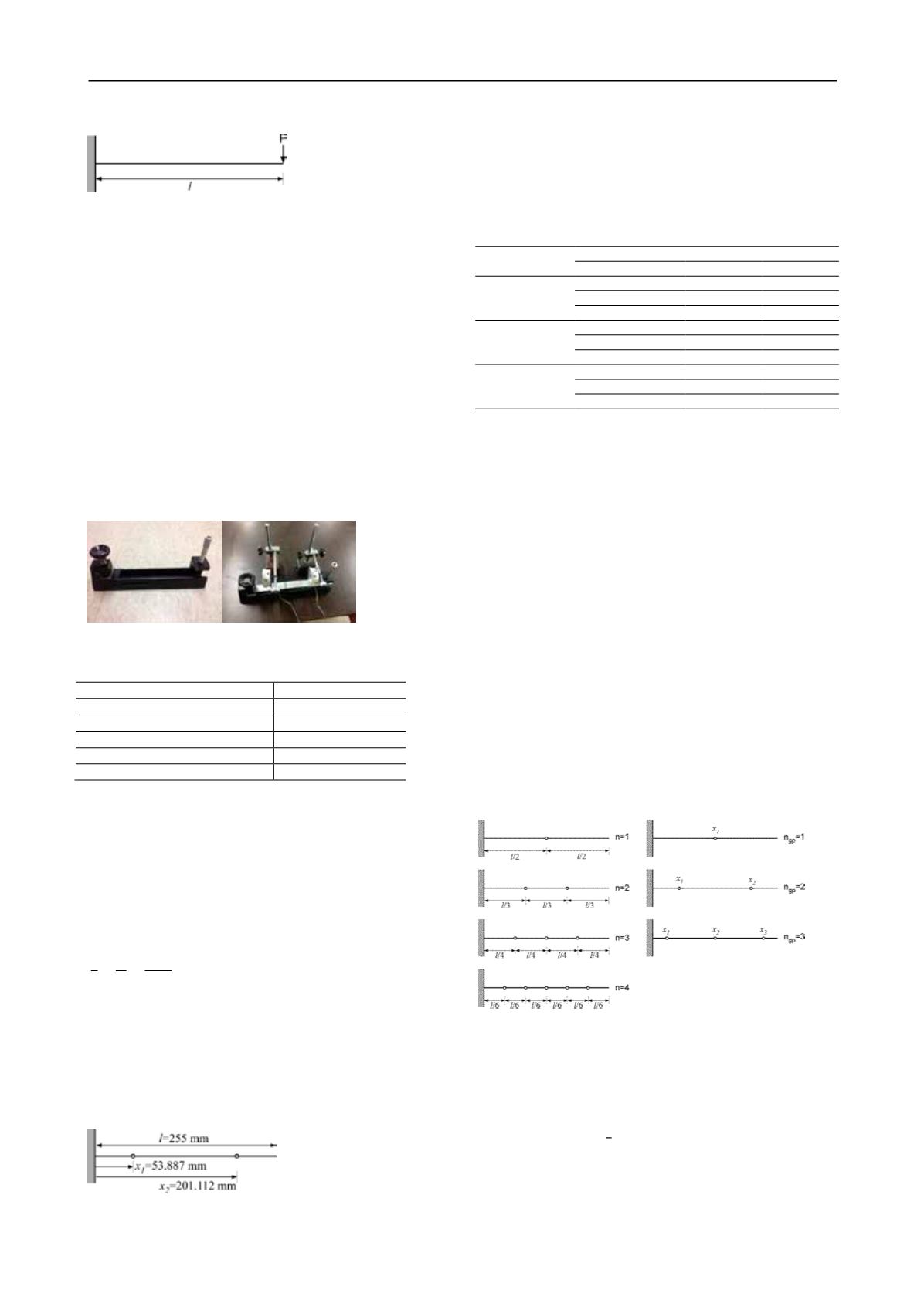
2769
Technical Committee 212 /
Comité technique 212
Figure 1. A cantilever beam with a concentrated load, simulating the
pile subjected to a lateral load.
2 EXPERIMENTAL SETUP
2.1
Experimental procedure
A model cantilever beam is the aluminum bar specimen which
has a physical properties listed in Table 1. Figure 1 shows the
loading system including a clamp to fix one end of the bar and a
calipers used to apply the displacement on the other end of the
bar. In the middle points, two dial indicators were attached to
measure the deflections of the bar during loading. Because the
displacement is applied by using the calipers, the concentrated
load, P, can be estimated as
P
= 3
/
. An optic fiber
including FBG sensors inscribed at given positions was epoxied
on the top surface of the bar specimen developing tensile strains
during loading. Electric strain gages were glued together to
validate the performance of the FBG sensors.
Figure 3. A model cantilever beam system.
Table 2. Properties of aluminum bar speciment
Length,
l
(mm)
255
Thickness,
h
(mm)
6
Width (mm)
25
Young’s Modulus,
E
(Gpa)
70.56
Moment of inertial,
I
(mm
4
)
450
Bending stiffness,
EI
(N
·
mm
2
)
31,752,000
As in Eq. (11), the lateral displacement, y, is obtained by
integrating Eq. (10) which is a polynomial equation with degree
2 so that two Gaussian points,
ξ
1
= -0.577 and
ξ
2
= +0.577, are
possibly chosen according to Table 1. As shown in Figure 4,
sensors were located at two points projected from two Gaussian
points. The FBG sensors measure the strains via Eq. (3). When
the point load, P, is applied, the cantilever beam specimen is
deflected. The curvature, 1/
ρ
, at a section can be calculated by
the strains developed on upper and lower surfaces as
=
=
(12)
where
is the tensile strain on upper surface,
is the
compressive strain on lower surface of the bar, and
h
is the
thickness of the section of the bar specimen. Assuming that both
tensile and compressive strains have the same magnitude, the
sensors were attached only on the upper surface of the bar
specimen. Consequently, the moment at the sections where the
sensors were placed can be measured as
= 2
/ℎ
.
Figure 4. Optimal sensor positions for a cantilever beam
For a given displacement, theoretical values of the moment can
also be computed via Eq. (9) and (11), thus
= 3
−
/
for a given
y
max
value. As shown in Table 3, errors in the
measured moment to computed moment range between 0.15
and 1.54%, and average out to 0.82%.
Table 3. Measured and computed moments at two Gaussian points
Applied
deflection,
y
max
Moment, N-mm
Sensor position
x
1
x
2
1 mm
Measured
1153.6
295.3
Computed
1155.3
309.6
Error, %
0.15
0.46
2 mm
Measured
2290.4
612.8
Computed
2310.7
619.2
Error, %
0.88
1.03
3 mm
Measured
3435.6
914.458
Computed
3465.9
928.8
Error, %
0.88
1.54
2.2
Optimizing sensor positions using Gaussian points
Primary objective for deployment in this study is to minimize
the error in measuring the maximum deflection at the point of
loading,
. Herein, we developed three optimization
strategies. The first strategy is positioning sensors at regular
intervals, which is a simplest way to deploy. The second is
positioning sensors at projected Gaussian points but not
following the Gaussian quadrature rule. The third is positioning
sensors exactly based on the Gaussian quadrature rule.
Figure 5 illustrates different deployment schemes according
to first and second strategies. Four possible schemes at regular
intervals are illustrated in figures on the left-hand-side column
of Fig. 5, where n is the number of sensors used for each
scheme. Figures on the right-hand-side column of Fig. 5
illustrate three deployment schemes using the projected
Gaussian points for the number of Gaussian points,
n
gp
= 1, 2,
and 3. For each case, the FBG sensors on a single strand were
inscribed at positions marked as open symbols in Fig. 5. After
applying
by the calipers, the strain at each sensor position
was measured by FBG sensors. Subsequently two unknowns
such as
P
and
l
in Eq. (8) were determined by using measured
strains incorporated with the boundary condition at the clamped
end, and then
was calculated via Eq. (11).
Figure 5. Different sensor deployments at regular and Gaussian points
The third strategy requires a double integral to calculate
using the moment values as described in section 2.3. Using the
Gaussian quadrature rule,
can be obtained by integrating
the slope function, S, which is the polynomials of degree 2, as
=
=
[
+
]
(13)
where
and
are weights for two Gaussian points given in
Table 1, and
and
are the distances from the clamped end
to projected Gaussian points as illustrated in Fig. 4. Because the


